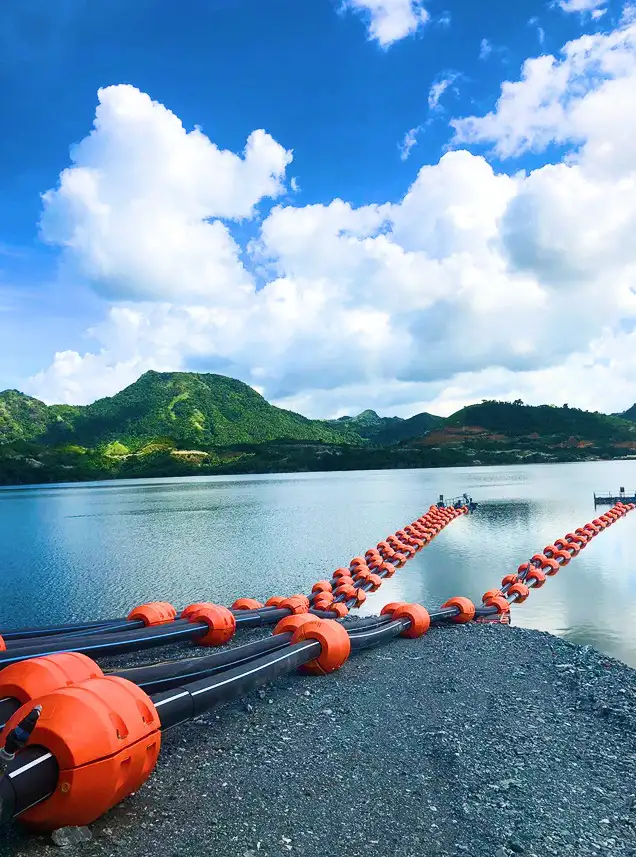
Polyethylene floats are essential buoyancy devices used across a vast range of marine, industrial, and recreational applications. Valued for their exceptional durability, cost-effectiveness, and versatility, these floats have become the industry standard for everything from supporting dredging pipelines to constructing modern marina docks.
A polyethylene float is a buoyant device made from polyethylene, a durable and corrosion-resistant plastic. These floats are designed to float on water and are utilized in a wide range of applications due to their advantageous properties.
Buoyancy: Their primary function is to provide flotation, whether to regulate water levels, support structures, or keep pipelines afloat.
Durability: Polyethylene is known for its strength and resistance to physical wear, impact, and harsh environmental conditions like UV exposure and temperature fluctuations.
Corrosion and Chemical Resistance: They are highly resistant to water, chemicals, and marine growth, ensuring long-lasting performance in various aquatic environments.
Lightweight: Being lightweight makes them easy to handle, install, and transport, reducing overall costs.
Low Maintenance: Their robust construction and resistance to degradation mean they require minimal upkeep.
Versatility: They can be manufactured in various shapes and sizes to suit specific application requirements.
Eco-friendly: Many polyethylene floats are made from recyclable materials and have a low carbon footprint.
Polyethylene floats are incredibly versatile and find use in numerous industries:
Water Level Control: Spherical polyethylene floats are commonly used in float valves to regulate water flow in tanks, reservoirs, and irrigation systems. They rise and fall with the water level, activating the valve to maintain desired levels.
Offshore and Subsea Operations: Polyethylene hose and pipe floats are crucial for laying pipes and cables in offshore and subsea environments. They provide buoyancy to keep pipelines afloat during installation and ensure their stability in water.
Dredging and Mining: In dredging operations, pipe floats keep discharge pipelines afloat, facilitating the transport of sediments, sand, and debris. They are also used in mining for tasks like tailings management and dewatering.
Marine Construction: Used in the construction of floating docks, jetties, and walkways, providing stable and durable flotation.
Aquaculture: They support fish cages and nets, enabling fish farming in open water.
Environmental Management: Employed in projects like wetland restoration or pollutant control to support the safe transfer of materials and water.
Buoys and Markers: Used as warning objects for shallow water or near-shore installations, often incorporating warning lights or reflective strips for high visibility.
Construction (Troweling): Reticulated polyethylene floats are used by professionals for finishing mortar plastering due to their lightweight nature and resistance to wear and water absorption.
Polyethylene floats are typically manufactured using processes that allow for the creation of hollow, durable products:
Rotational Molding (Rotomolding): This is a common method where polyethylene powder is added to a mold, which is then heated and rotated along two axes. The plastic melts and evenly coats the inner surface of the mold. After cooling, the hollow product is removed. This process is suitable for large and complex shapes and results in products with minimal internal stress. The interior is often filled with closed-cell foam (like polystyrene or polyurethane foam) to enhance buoyancy and impact resistance, even if the outer shell is compromised.
Blow Molding: This process is used for creating hollow plastic parts. A molten plastic parison (tube) is inflated inside a mold, forming the desired shape. Blow molding is also used for a wide range of sizes and custom shapes, including floats for docks and aquaculture aerators.
Co-extrusion: For some floating structures, co-extrusion might be used to create an outer layer with specific properties (e.g., color, UV resistance) simultaneously with an inner foundation.
In essence, polyethylene floats are indispensable components in various sectors due to their inherent buoyancy, resistance to harsh conditions, and ease of use, making them a reliable solution for flotation and liquid level control.
